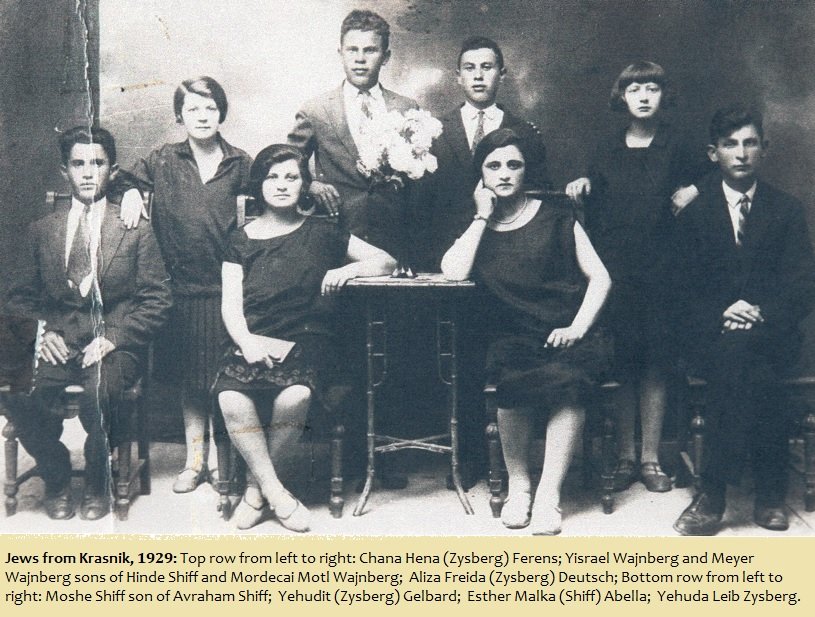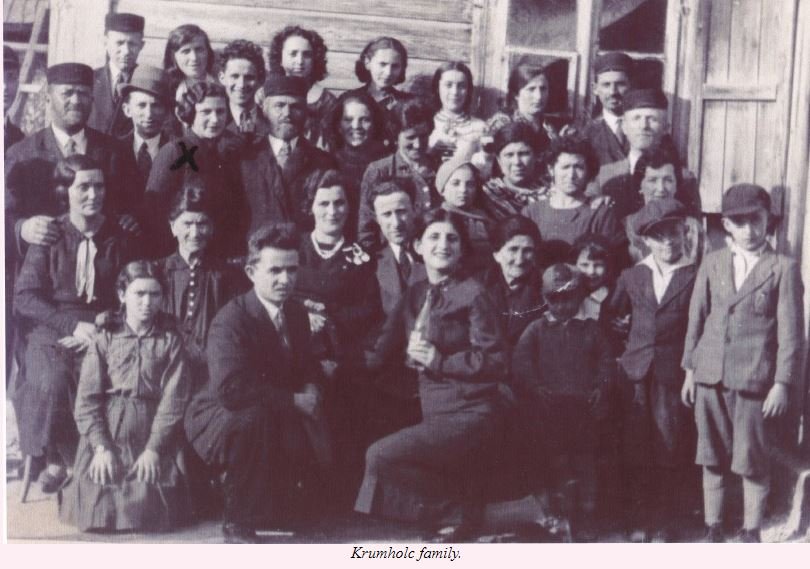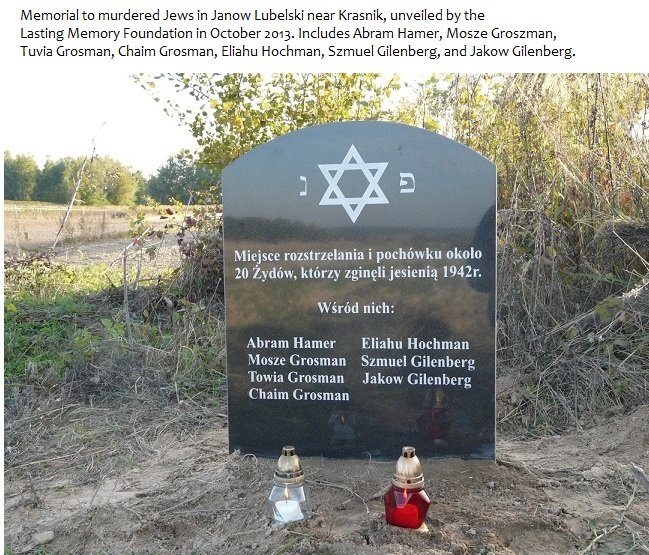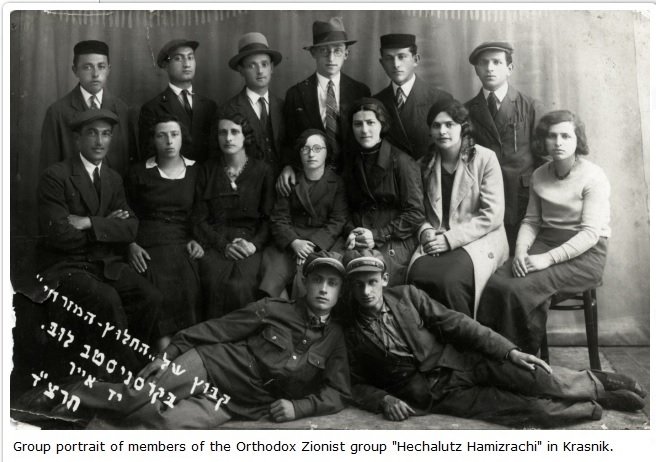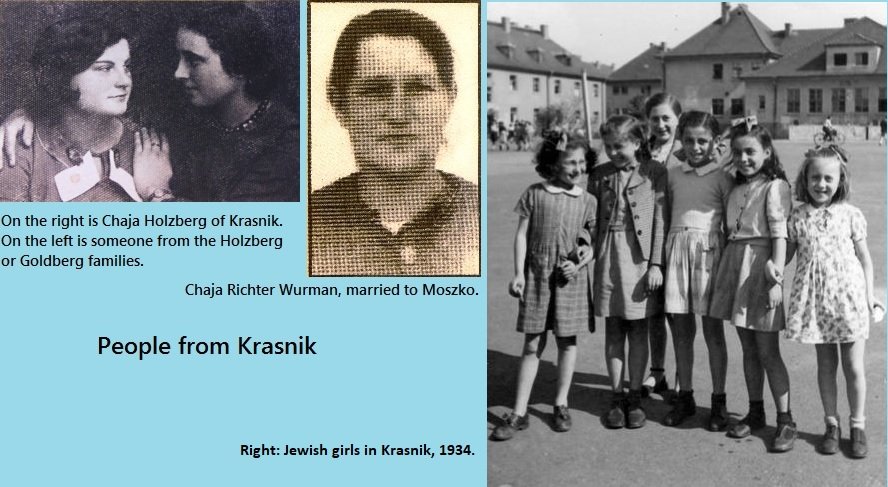Remember Jewish Krasnik
Pronunciation: Kroosh-nik
HISTORY OF JEWISH KRASNIK
Krasnik is a town in southeast Poland, with a population of 37,989 and divided into two parts: Lubelski (or Stary) and Fabryczny. The old Krasnik, where the historic buildings are located, is Krasnik Lubelski. The town is located 49 kilometers southwest of Lublin. Jews lived in Krasnik dating back to at least 1531. In 1631 there were 300 Jews out of 3,300 people.
The community numbered 1,353 persons in 1765 (921 in the town itself). The majority of the Jewish workers in town were tailors. The Jewish population was 1,778 in 1857, a little more than half of the total population, and 3,261 in 1897, or 50% of the total population. In 1921 the Jewish population numbered 4,200. Over 5,000 Jews lived in Krasnik before the outbreak of World War II.
In Krasnik in 1930, the rabbi was Jankiel Wajsbrot; the secretary was Z. Szor or Szoor; the synagogue choir lead was M. Wurman; the singer at the old house of prayer was J. Kacenberg; the szames was B. Fadiuk; the janitor was J. Frajman; the butcher was B. Feder; the shochets were Sz. Rajs and Icek Halperman; the former school employee was G. Griner (female). In Urzedow near Krasnik, the rabbis were Majer Goldhar and Abram Wajnsztok; the shochet was Jakub Wajman; the synagogue caretaker was Jankiel Wertman; and Josef Wajman and Herszek Ajdelsztajn were also involved in some capacity.
Houses of prayer, in 1922, were run by the following: S. Ejger; M. Fogel; N. Klarfeld; D. and I Kohen; Z. Lamhaut; Ch. Milerman; M. Niderman; D. Rajzman; J. Sztetlman; Ch. Tenenbaum; J. Wajsbrot; B. Waks; Hersh Wizniak; A. Wolberg; M. Zajdenfeld; and C. Zysberg. Krasnik's 1939 Jewish population was 5,500 Jews. Jewish communities near Krasnik included: Blinow (25 Jews), Ludmilowka (unknown Jewish population), Suchodoly (75 Jews), Trzydnik (unknown Jewish population), Urzedow (509 Jews) and Zakrzowek (818 Jews).
HISTORY OF JEWISH URZEDOW
Urzedow is a village 6 miles northwest of Krasik. It had 11 Jews in 1781. In 1860, a ban on Jewish settlement was lifted in Urzedow, and by 1886 there were 153 Jews in town. 509 Jews lived in Urzedow in 1939 -- about 40 Jewish families. On September 23, 1939, as a result of the policy of the Germans, Jewish children were removed from public schools. From January 5, 1940, Jews in Urzedow were forced to self-identify as Jewish by wearing an armband. Manasha Szajnbrum was a local Judenrat member who was exceptionally brutal toward the Jews of Urzedow. In May 1941, Jews from Wawolnica were sent to Urzedow. By late 1941, 70 Jews from Vienna were sent there. By June, 1942, there were 541 Jews in the Urzedow ghetto. The liquidation of the ghetto took place in October 1942. All Jews who were able to work were transported to the camp in Budzyn, and the rest of the population were taken to the ghetto in Krasnik. In November 1942, those in the Krasnik ghetto were sent to Belzec extermination camp. Jewish life in Urzedow ceased to exist.
THE HOLOCAUST IN KRASNIK
On September 15, 1939 the Germans chased dozens of Jews to the synagogue. There, on Sept. 15 and 16, the Nazis burned scrolls and books. Jews were also forced to open their shops during Rosh Hashanah. The German army entered the town in September, 1939. On November 23, 1939 the Nazis formed a Jewish Council (Judenrat) which was composed of 12 people including Fiszel Rabinowicz; Jozef Szapiro; Zelig Beatus; J. Wajsbrot; Ferleger; Avraham Dawidson; Shmuel Flug; Simcha Kohen; Pesach Kawa. In total, about 6,000 Jews were confined to this ghetto. Others from the city were relocated to a labor camp and ghetto in Zaklikow. On April 12, 1942, around 2,000 Jews were deported to the Belzec Camp. On Nov. 1, 1942, another 2,700 were deported to be murdered in the gas chambers at Belzec. Near to Krasnik, a number of labor camps were set up: Budzyn, Krasnik (WIFO/Skret), Zaklikow and Janiszow. The Budzyn location offered 55,000 square meters of space and adequate housing for S.S. members who lived in the district.
At Budzyn, there were eight wooden barracks. Heinkel established a factory for aircraft construction at the camp by using S.S. forced labor in 1942. By 1943, the camp numbered about 3,000 Jewish prisoners. After October 22, 1943 the camp became an independent concentration camp and was no longer a sub-camp. The daily march by the prisoners to the work sites took from 45 to 60 minutes. The living compound for Jews at the camp was composed of six barracks similar to Majdanek . The barracks were surrounded by a barbed wire fence. Much of the forced labor was done under the supervision of German or Polish civilians from the Heinkel airplane company. In the camp were Jews from Annopol, Belzyce, Krasnik Janow Lubelski, Hrubieszow, Minski, Mohylow, Smolensk, Vienna, and Slovakia. With the help of Tadeusz Szymanski, a group of 13 Jewish prisoners at Budzyn were able to escape in January of 1943. They subsequently joined a unit of partisans based near Krasnik. It is unlikely anyone from this group of 13 survived the duration of the war.
In April 1943, there were 750 Jews in the Budzyn camp, which "due to prolonged undernourishment" were not likely to be sustained. By the second half of 1943, there were again 3,000 Jews at Budzyn. In May-June of 1944, the camp was evacuated and the prisoners moved to labor camps in Skazysko, Starachowice, Radom, and Plaszow. Only a few of these Jews survived. On June 10, 1944, Budzyn prisoners were transported to Majdanek. The camp was dissolved on July 22, 1944 and the prisoners staying there were taken to the camps at Plaszow or Mauthausen.
In March 1941 the Krasnik (Skret) camp numbered about 200 Jews. On the May 20, 1943, S.S. Groeger and Kiplow carried out executions of at least 34 prisoners in the Skret camp. Among those shot were nine children aged from eight to twelve. During the summer of 1943, Groeger shot the Jewish prisoners Moshe Graf and Moshe Szif at Skret.
Between November 3-7, 1943, the largest labor camps in the Lublin region were liquidated, and most of the Skret inmates in the district were murdered directly or sent to be murdered at Belzec Death Camp or Sobibor Death Camp. After this, only two S.S. labor camps remained in the Lublin district for Jews: Budzyn and Skret. Fearing what was to come, there was a mass escape attempt on February 17, 1944 aided by partisans in Rzeczyca including the Russian Jew Iwan Kasjan (Kasian). Seven Jews managed to escape.
When the Russians approached Krasnik, a large number of the Skret prisoners were transported to other camps further west. Just 300 Jews remained by July, 1944. Out of a population of more than 5,000 Krasnik Jews, an estimated 350 survived the Holocaust. Those who survived left Poland.
Jews in the Krasnik area were also sent to the following labor camps during the war period: Lysakow: 500 were forced to work in a quarry; Goscieradow: 200 Jews; Janiszow: 900 Jews were forced into labor on irrigation works; and Rachow: 500-600 Jews had forced labor at a mine.
The "synagogue" labor camp was established in the ghetto (Szkolna Street and Boznicza streets). It was located near the synagogue. After the ghetto's dissolution and transportation of the Jewish population to the death camps, tailors, shoemakers and carpenters who had survived were employed by the Germans to work in the camp. They were given the task to renovate a few buildings for the Germans and to finish building of a tenement house in Pilsudskiego Street. In March of 1941 the camp numbered about 200 Jews. The camp commandant was Alois Groger. The guards were: Franz Bartetzko, Klein, Koplok, A. Nazaruk and W. Zdonczuk. The Jewish police, composed of 12 people, was led by P. Kawa. Work in the camp lasted a dozen or so hours a day. The members of the staff created a theatre in the synagogue where poems of the Jewish poets were presented. Jews at the camp got in touch with the guerrilla fighters in Rzeczyca at beginning of 1944. A Jewish security guard named Kasjan was the leader. Their objective was to prepare an escape on a large scale. The commandant of the Jewish police, Mr. Kawa, participated in the preparations of the action. When the Nazis discovered the plot, dozens of Jews were shot by firing squad. The liquidation of the camp was conducted by Bartetzko. Surviving Jews were sent to Annopol or the Plaszow concentration camp.
NAZI MURDERERS IN KRASNIK
The Nazis who carried out the murders in Krasnik included: Odilo Globocnik, Georg Michelson, Artur Axmann, Hans Asbach, Hans Augustyn, Erich Augustine, Franz Bartetzko, Wilhelm Becker, Friedrich Buschbaum, Max Ehrle, Reinhold Feix, Herbert Kurt Franke, unknown Georgi, Alois Groger, Otto Hantke, Gustav Hanolt, unknown Klein, unknown Koplok (or Kiplow) from Latvia, Willi Kleist, unknown Krener, unknown Krieger (probably F.W Krueger), Hans Lauffs, Josef Leipold, Hans Lenk, unknown Meizen, Dr. Mosbach (or Mutersbach), Otto Mohr, Herbert Naumann, Johan Offerman, unknown Pronenberg, Freidel Rau, Janis Reiters, Willi Reiters, unknown Schlesinger, Josef Scharen, unknown Schwenk (possibly Fritz Schwenke), Bernhard Schulze, Edward Shutt or Schmidt, Jakob Sporrenberg, Siegmund Stegmann, Otto Strossenreuther, Karl Streibel, Heinrich Stoschek, Adam Ulrich, Karl Ulbrich, and Henning von Winerfield. Low-level guards included A. Nazaruk, Mykola Wasylyk and W. Zdonczuk.
Globocnik, Friedrich Wilhelm Kruger, and Fritz Tauscher committed suicide. Leipold, Shutt, and Stegmann were executed while Hans Augustin, Hans Lenk, and Bartetzko were killed before the end of the war. Hantke and Groeger received life imprisonment sentences. Few of the others were punished.
AFTER THE WAR
At the park on Sikorskiego Street there is a granite commemorative plaque fixed to memorialize the victims murdered by the Nazis from 1940-1944. It was brought from the Urzedow Forest in 1964. In the building of Primary School No. 2 in Krasnik located at 10 Urzedowska Street, a commemorative plaque was set in the wall with the Polish and Jewish inscriptions dedicated to the Jewish students and teachers of the school who were murdered by the Nazis in the years 1939-1944. The plaque was funded by the Nissenbaum family's Foundation in April of 1990.
The Great Synagogue in Krasnik was established shortly after the settlement of Jews at the end of the 16th century. The first mention about the synagogue dates back to 1593. It was rebuilt at a different location, Bozniczna street, after a fire in 1637. A brick-based synagogue which could house 300 men and 400 women was constructed between 1637 and 1654. In 1875 the synagogue was renovated. The main prayer room had a surface wooden tunnel vault. After the end of the war in 1945 the building was renovated and used as workshops for a crafts cooperative. In 2005 the Foundation for the Preservation of Jewish Heritage gained ownership. It is now open to visitors at cost, and the proceeds go toward preservation. There is also a plan to renovate the whole synagogue complex and to establish a cultural and educational center inside, which would be part of the "Hassidic Trail". A smaller synagogue also sits on Bozniczna Street. It was erected between 1823 and 1857. There are five painting layers on the synagogue walls and three decoration painting layers on the ceiling. The synagogue was wrecked during the Holocaust, but is in the process of being restored. Like the large synagogue, it will be part of the "Hassidic Trail". A multimedia library is planned at the location. Numerous private houses of prayer existed in Krasnik before the war. Specifically, at the houses of Ejger, Fogel, Klarfeld, Kohen, Lamhaut, Milerman, Niderman, Rajzman, Sztetelman, Tanenbaum, Wajsbrot, Waks, Wisniak, Wolberg, Zajdenfeld, and Zysberg. There was also a mikvah on Bagno St.
There are three Jewish cemeteries in Krasnik. The cemetery on Podwalna Street was founded in the late 16th century and contained gravestones from the 16th and 17th centuries. The cemetery was destroyed during the Holocaust. The area of the cemetery was built up and no tombstones were preserved. The cemetery near Strazacka Street was founded in the second half of the 17th century. It was situated about 200 meters to the southwest of the market in Strazacka Street. The last burial took place at the beginning of the 19th century. The Nazis also devastated this cemetery. No gravestones survived. Currently there is a park at this location. The new Jewish cemetery at Szewska St. was established in the first half of the 19th century. The last known burial was held in 1943. From April to November of 1942 the Nazis conducted mass executions of the Jews in this cemetery. The area is surrounded by a wall and a monument has been erected to commemorate the Jews murdered by the Nazis during the Holocaust. The cemetery was cleaned up in 2006 by Israeli soldiers at the request of Yad LeZehava Holocaust Research Institute and the Foundation for the Preservation of Jewish Heritage. About ten gravestones are visible, and other gravestones are shattered or incomplete. A local group called the Regional Society of the Krasnik Lovers takes care of the monuments in the city.
Please review the site content below. Zachor - We Remember.
------------------------------------------------------------------------
[Surnames and Researchers] [Wikipedia - Krasnik]
[Books About the Lublin District Jewish Communities]
[Lublin Area Jewish Descendancy Organizations in Israel]
[Budzyn and Krasnik Labor Camps] [The Ludmilowka Pogrom]
[Liberation of the Janiszow Forced Labor Camp]
[Overview of Jewish Community and Chasidic Life]
[Jewish Partisans in the Lublin District]
[Krasnik Yizkor Book] [Janow Lubelski] [Zaklikow]
[Krasnik Jewish cemetery] [Nazi Reinhold Feiks]
[Family Research in Southeast Poland]
Click to subscribe to the Krasnik Facebook group
------------------------------------------------------------------------
Partial Listing of Krasnik Holocaust Victims
Among the Jews who were murdered in the 1941-1944, the names of 55 victims from Krasnik were established:
Benjamin Grinapel, Abram Graf, Zelik Goldner (Bozniczna Street), Ela Lederfajn (Szkolna Street), unknown Erlich, Jenta Rajndel, Wolf Rajndel, Gela Wajsbrot, Josek Beck, Frajda Dawidson, Choma Erlich, Ita Erlich, Abram Erlich, Judka Gutfrajnd (Wesola Street), Dawid Hirszbaum, Sarna Kessel (Narutowicza Street), Tauba Rozenbusch, Hudesa Rozenbusch (Kosciuszki Street), Choma Rozenbusch (Kosciuszki Street), Abram Szafran (Narutowicza Street), Rojza Szafran (Narutowicza Street), Majer Wajnberg (Narutowicza Street), Walla Wajnberg (Narutowicza Street), Bajla Zajac (Narutowicza), Zelik Beatus (18 Szkona), unknown Bankowska, Rachela Klocender.
Among the Jews from Krasnik who were shot by firing squad in the labour camp in Budzyn were the following persons: unknown Cymerman, unknown Dajtel (Krakow), Aron Fajngold (Trzydnik), unknown Ferst (Lodz), unknown Fersztman (Belzyce), Fryda Fiterman (Gesia Street), Izrael Fiterman, Jozef Golab (Trzydnik), unknown Herszkowicz (Warsaw), Bela Kawa (Gesia Street), Berek Kawa (Gesia Street), unknown Lewkowicz (Warsaw), Chaskiel Met; Kuszel Mogiluk (Smorgonie), Mojzesz Nudelman, Anciel Jankiel Pomaranc, Dr. Abraham Popko (Warsaw), unknown Rozencwajg, unknown Szwarchard, Josef Szwarcman (Janow Lubelski), unknown Wurman (Trzydnik), unknown Zabner (Warsaw), Fajwel Zajdenwerk (Zaklikow), and Chaskiel unknown.
In January, 1943, a group of Jews from Krasnik under S.S. Adam Ulrich were sent to Belzec. They were: Shimeon Zilberfajn, Moshe Porcelan, unknown Judkewicz, Yekul the baker's son-in-law, Shevekh Czizme's son-in-law, Zaduk Herszenharc, unknown Szwarc (locksmith), a carpenter from Zaklikow.
City of Krasnik LINKS:
Join the Krasnik Facebook group!
- Article: Bar Mitzvah takes family back to old Ostrovtzer Synagogue
- Article: Fabric of Remembrance: Krasnik
- Article: My Father's Holocaust Secret
- Congregation Anshei Krasnik in Brooklyn, New York
- Bychawa Yizkor Book Translation
- Revitalization of the Krasnik Synagogue
- Society for the Preservation of Jewish Heritage in Poland: Krasnik
- Sefer Krasnik: Yizkor Book
- Synagogue Revitalization
- Witness Testimony: Jozefa Seliga (Polish)
- Yizkor Book Online (no English)
- There was a shul on the lower east side of Manhattan called Anshei Krashnik Lubliner Gubernia which had 107 members. Its president was Morris Bernstein; Secretary, Hyman Wertheim Cemetery Plots of Krasnikers in NY - Listing of Surnames
Concentration Camps:
Belzec Concentration Camp
Budzyn Labor Camp (see also: Budzyn Camp)
A Description of Budzyn
Krasnik Labor Camp(Skret/WIFO)
Majdanek Concentration Camp
Families of Krasnik:
- Brantuch family
- Girenraich family
- Kessel family
- Rozenel family
- Wacholder family
- Weinberg family
- Zysberg family
Majdan Tatarski Ghetto Victims (Lublin) from Krasnik:
- Wolf Blacharz
- Jenta Ejzenberg
- Aron Klajnman
- Nusyn Kohen
- Judka Krymholc
- Lejzor Mandel Ajl
- Maja Dwojra Rochman, nee Perec
- Therese Weinstein, nee Fischer
- Izrael Lejb Zajdenfeld
(source: Brama Grodzka - Teatr NN)
Survivors of Krasnik:
Note: Additional survivors listed in Pinkas HaNitzolim II and Sharit haPlatah
- Jack Adelstein
- Dawid Ajzen (went to Sweden)
- Sidney Albers
- Menachem Bak
- Abraham Bergman
- Esther Hauszpiegel Bielski
- Eugene Bines
- Roland Blad
- Laca Bojm (went to France)
- Moishe Botner
- Abraham Brand
- Shmuel Brand
- Benzion Brejer
- Barbara Briks
- Jack Briks
- Hersh Bronz (Brones)
- Shalom Buchbinder
- Jack Ciszma
- Daniel Datum
- Hela Datum
- Zvi Datum
- Eliezer Davidszon
- Moshe Davidszon
- Max Edelman
- Jankiel Ender
- Moshe Fayngold
- Usher Farber
- Chemja Feder
- Isidore Feld
- Doris Feldstein
- Menashe Fraydenberg
- Salomon Friedeburg
- Joseph Fox (Fuks)
- Dvora Fux
- Sholem Garen
- Icek Gerenrajch
- Jakob Gerenrajch
- Lejb Gerenrajch
- Motel Gerenrajch
- Shlomo Gerenrajch
- Chaja Goldbaum
- Dawid Goldfarb
- Nechemia Goldman (went to Israel)
- Shmuel Goldner (went to Israel)
- Chaim Goldrajch
- Hudesa Mincberg Gora
- Moshe Gradel/Gradek
- Zelman Grosman
- Sam Grungold
- Hanka Grynbaum
- Ewa Grynberg
- Hersz Josef Gutwillig
- Moszko Chaim Gutwillig
- Tewel Herynger
- Bernard Herynger
- Rachela Herszon (Rita King)
- Abe Hill (Abram Himelblau)
- Drucka Kahan
- Abe Knipper
- Wolf Hall (Hauszpiegel)
- Henry Hochrad
- Szyja Hochrad
- Jack Holzberg
- Boleslaw Janowski
- Ethel Kirschenbaum
- Mona Klempner
- Ryfka Konn (went toEngland)
- Josef Korn
- Frances Krowicki
- Moszko Lachter
- Itzhak Lamhut
- Morris Lang
- Abram Liberman
- Simon Lipsutz
- Abraham Majzner
- Adam Mandelblatt
- Michal Mazur
- Laura Melmed
- Abram Milchman (Milechman)
- Yehoshua Minz
- Hodes Mincberg
- Rochel Murminsky
- Laja Obermajster
- Abraham Olender
- Alter Chaim Olender
- Yaakov Onder (Ander)
- Alja Openheim
- Chula Openheim
- Szlomo Peled
- Shamei Perelson
- Anshel Pomeranc
- Azriel Rochman
- Josef Rosenbush
- Leibish (Aryeh) Rosenbush
- Szija (Yehoshua) Rosenbush
- Moshe Roshgold
- Stephan Ross
- Hancia Rotenberg
- Zvi Hersh Rozenbush
- Hersz Rozenel (went to Sweden)
- Lejb Rozenel (went to Sweden)
- Nakhum Rozenel
- Lea Ryba
- Natan Salzman
- Asher Sambor
- Leon Schor- Wolf Seidenberg
- Morris Sharfstein
- Berel Stahlhammer
- Mischa Stahlhammer
- Abraham Sontag
- Fiszel Swerdszarf
- Jay Sunday
- Icek Taublib
- Dawid Tenenbaum
- Shlomo Tenenbaum (went to Israel)
- Zelda Tenenbaum (went to Israel)
- Yechiel Tepper
- Szulim Trambuch
- Yaakov Tsukert- Ber Twardagur
- Nachman Wagman
- Abraham Waks
- Szloma Waks
- Regina Warsaw
- Motek Waserman
- Henoch Zaklikowski
- Gabriel Zis
- Elliott Zuckier
- Beniamin Zylberberg
- Jumek Zylberberg
- Abraham Zysberg
- Jacob Zysberg
- Chawa Zysberg
- Mordechai Zysberg (Sisberg)
- Szlomo Zysberg
- Rose Zysberg
Survivors of Modliborzyce:
- Alan Nisenbaum
Survivors of Potok:
- Max Boimal
- Aryeh Shaked
- Lola Sztrum
Survivors of Urzedow:
- Helen Erlich
- Gary Flumenbaum
- Rozia Perelman
- Moshe Rosenberg
Survivors of Zakrzowek:
- Bernard Aptekar
- Nathan Aptekar
- Stanley Aptekar
- Boris Boiarskii
- Esther Cajg
- Abraham Ehrenberg (Erenberg)
- Gedelia Ehrenberg
- Icek Ehrenberg
- Jonah Ehrenreich
- Szyja Engel
- Zysel Kalutro
- Tereza Kawa
- Moszek Rojzer (Roizer)
Rabbis of Krasnik:
- Meir Brenner- Abraham Eiger, 19th century
- Moshe Furman, cantor
- Izrael Abner Grynbaum
- Gerszon Hercog
- Aron Hochman
- Eliezer Kislowitz (Kieslowitz)
- Yechiel Kleiman of Bychawa
- Nechemia Steingus
- Reuven Azriel Zysberg
Notable Residents:
- Rabbi Wolf Greenglass
- Wolf Wajsbrot
Righteous Gentiles of Krasnik:
- Edwarda Bos
- Maciejewski family
- Marcin Nastaj kept Sara Fiszman hidden near Zakrzowek
- Apolonia Oldak saved Basia Tenenbaum; both later moved to Israel
- Marianna Pawezka helped hide a teenage Jewish girl
- Sikora family
Remember Your Family:
Central Judaica Database - Museum of History of Polish Jews
Grandchildren of Holocaust Survivors on Facebook
Guide to the YIVO Archives
Holocaust News/Events from Generations of the Shoah Int'l
Holocaust Survivors and Victims Database
JewishGen Family Finder
JewishGen Holocaust Database
JRI-Poland: Search for Your Family
Museum of History of Polish Jews Introduction
Yad Vashem: Search for Your Family
Yad Vashem: Submit Names of Your Family Members
Yad Vashem Requests Photos of Shoah Survivors and Families
Genealogy:
Jewish Records Indexing Poland - Krasnik
Jewish Vital Records in the Polish State Archives
CONTACTS
U.S.: LublinJewish@gmail.com
Return to Lublin Index
